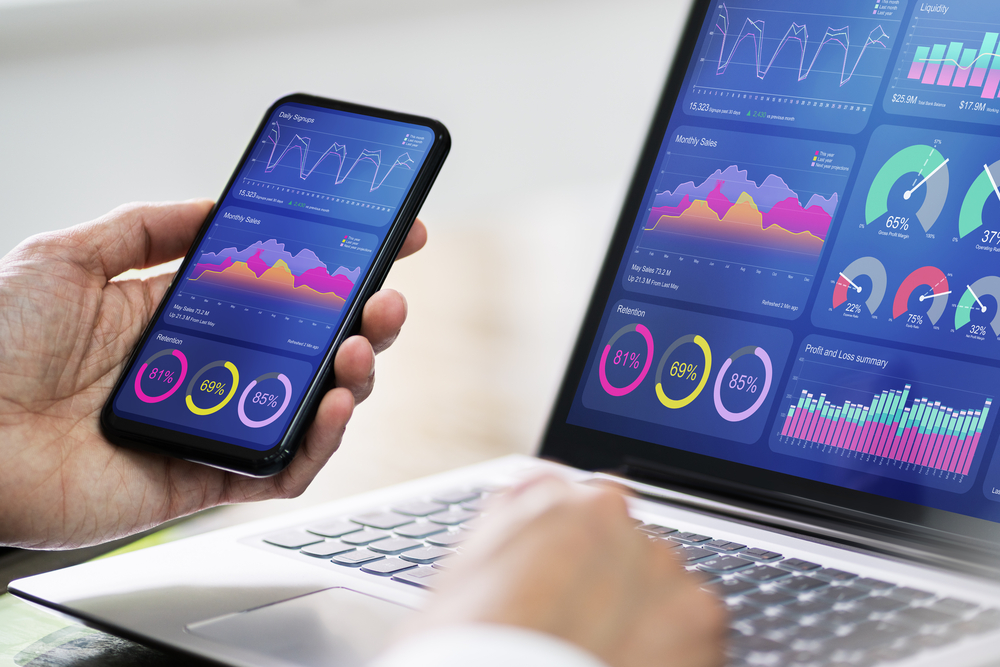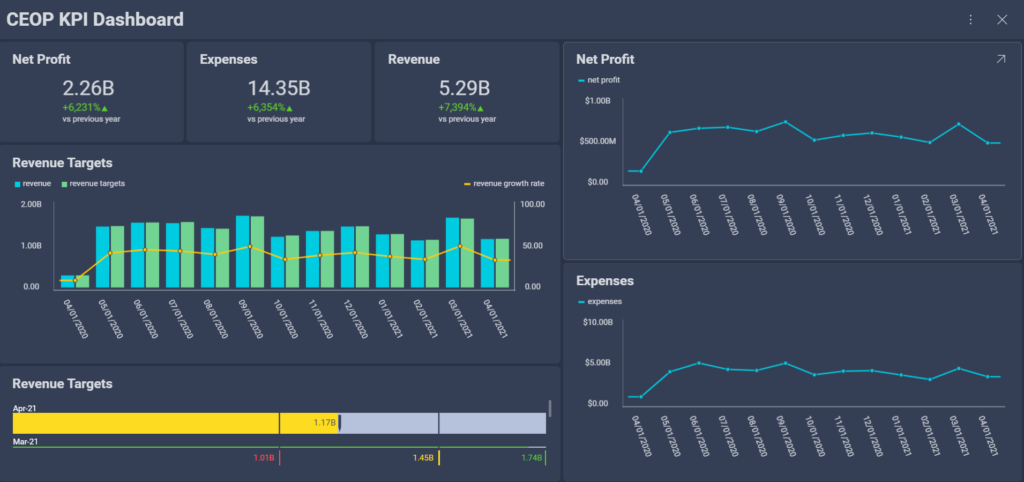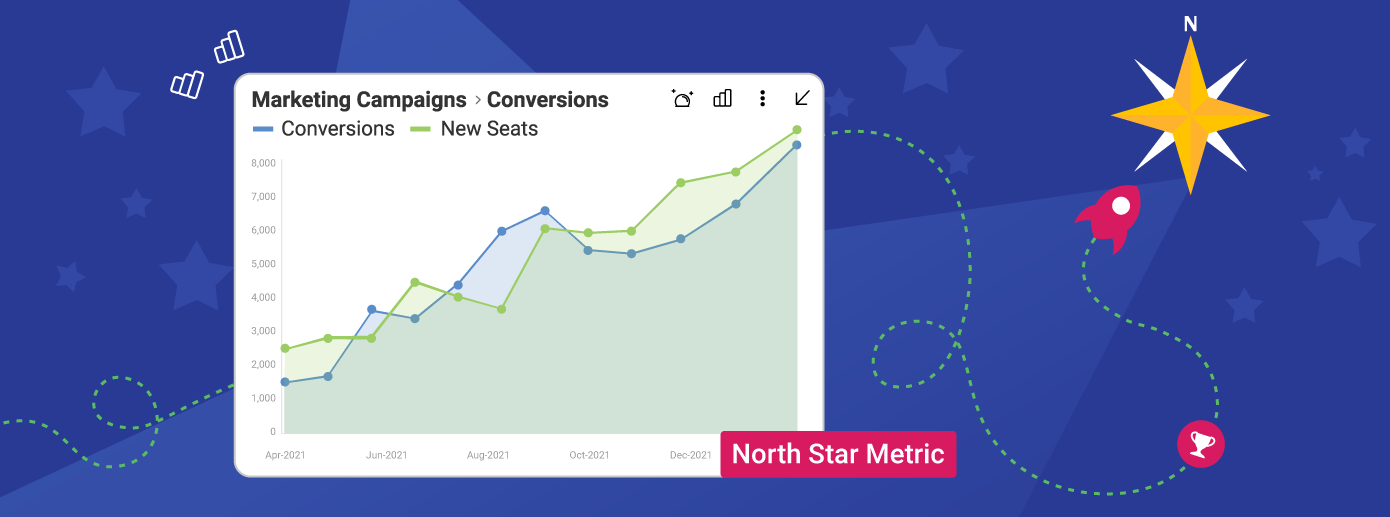
Top 10 CEO KPIs to Have in Your Dashboard
CEOs need easy and quick access to their KPIs – they need a CEO KPI dashboard that allows them to monitor how their business is performing at a given time period.
Executive Summary:
CEOs need easy and quick access to their KPIs – they need a CEO KPI dashboard that allows them to monitor how their business is performing at a given time period.
In a series of 26 interviews with CEOs, The Harvard Business Review* identified 3 key issues which were worrying business leaders around the globe.
They found that one of the major challenges for them is finding and retaining the right staff. Another big for CEOs is the impact of operating in a global market – navigating this context and keeping a company of thousands of individuals unified is extremely difficult.
And finally, their third biggest worry is managing change as the business comes under pressure from compliance and legislation.
As any leader will know, there’s never enough time for everything.
When you are managing organizational politics, attempting to steer the company to growth, or differentiating your brand from the aggressive competition; maintaining a focus on your Key Performance Indicators (KPIs) can often get left behind.
Nonetheless, your KPIs should form the bedrock of your business, and be used by all your teams to measure their progress.
Of course, not every KPI is applicable in every business. Still, there are several key metrics that every CEO will want access to instantly, whether they are on the plane, drinking their morning coffee, or between meetings.
Having these close at hand from your mobile or tablet helps maintain focus on the goals you have set for your business.
What Are KPI Metrics?
A Key Performance Indicator (KPI) is a measurable value that proves whether a company is achieving its key business goals or helps you understand how your organization and different departments are performing. KPIs are typically used to evaluate businesses’ success at reaching targets and provide a focus for strategic and operational improvements.
The main benefit of the KPIs is that they allow you to create an analytical basis for decision-making and drive your attention to what matters the most.
As the famous Austrian management guru and author Peter Drucker said ‘’What gets measured gets done’’.
What Are the Most Common KPIs for Executives?
As we mentioned, not every KPI is applicable in every business. There are thousands of KPIs to choose from, from sales and financial KPIs to operational, marketing, and customer KPIs and more.
Executives have the challenging task to lead a company in times of extreme changes and must be able to take strategic decisions to grow their business. Having the right KPIs on a dashboard at your fingertips is very important to ensure that you are on the right track.
So, what KPIs you should be measuring?
You are not going to love this answer, but it depends. It depends on the type of business, what problems the business is trying to solve, what do you want to improve, etc. However, there are some common KPIs for executives that should be on most CEOs’ dashboards.

Top 10 CEO KPIs
In this article, we gathered KPI examples for CEOs that we believe every business leader should be measuring and focusing on. These are top the CEO KPIs you need to keep your eyes on:
Net Profit
This should be obvious but keeping an eye on net profit at all times is essential for business leaders. The net profit KPI measures how successful your business is at generating profit on each dollar of revenue you bring in. It is a powerful instrument in making both short and long-term financial decisions.
This might be visualized as a line graph or quarterly chart. However, you decide to represent the data, it needs to provide detailed, regularly updated information.
How to calculate your net profit:
Net profit = Sales revenue minus the total costs of the production of good and services
Progress Towards Targets
When you set quarterly, annual, and long-term targets, you need to keep your eyes on your goals. This kind of information can be represented visually with a simple comparison of ‘actual’ profits and ‘expected’ profits. You will be able to quickly compare how the company is doing, reassure shareholders and make crucial decisions.
Revenues and Revenue Growth Rate
One of the most important CEOs’ KPIs is revenue growth. The revenue growth rate measures how a company’s sales are increasing or decreasing over a given time period.
By being able to instantly visualize how fast (or otherwise) your business is growing its revenues, it is much easier to find out what is going right and what is going wrong. Need to lose some dead weight? Invest in a growing department? Respond to a new trend among consumers? Tracking your revenues closely is crucial and will help with those decisions. A line graph would again be particularly clear in this instance.
How to calculate your revenue growth rate:
Compare the current revenue (from a given time period) to that of the previous equivalent time period.
Expenses
Whether it is staff, machinery, IT, or property, your expenses are one of the biggest drains on your long-term success. A CEO KPIs dashboard can break these down instantly so you can see where your biggest outgoings are, and then make decisions about what’s costing too much.
Revenue per Employee
Revenue per employee is a little like ROI (return on investment). Are your people actually making enough revenue to justify hiring them? Are they working at 100% capacity or is there room for them to work more, instead of employing new workers? A revenue per employee dashboard helps you make these choices rationally.
How to calculate your revenue per employee:
Revenue per employee = divide your revenue by the number of full-time employees
Employee Engagement
If your people are motivated, enthusiastic, and giving their work 100%, you can rest assured that your company will grow. By contrast, unengaged colleagues will be a detriment to productivity. It is essential to keep regular tabs on how employees are feeling about their work.
How to measure your employee engagement:
Employee engagement is a key BI (Business Intelligence) factor for any CEO and is easily measured by anonymous surveys. The general rule is that the more frequent the surveys are the better.
Here are some questions that you can include in your employee engagement survey:
- How valued the employee feels?
- How satisfy the employee is with its work/life balance?
- How does the employee feel about its career prospects?
Profit per Customer
This is an easy one. Profit per customer, income per customer, or customer profitability score helps you understand how much revenue each individual customer is generating.
How much are your customers spending? How this is represented on your CEO KPIs dashboard depends on the market you work in – whether it’s B2C, B2B, or B2G. By building better relationships with your customers and improving loyalty, you can expect a profit per customer to increase.
How to calculate your profit per customer:
Profit per customer = revenues earned from a customer in a given time period minus the cost of supporting the customer in the same time period
Order Fulfillment Cycle Times
The faster you complete orders, the faster you can invoice. Further, rapid order fulfillment equals impressed and loyal customers. As a CEO, you should keep a constant eye on progress here, and a simple dashboard can represent delays clearly and help you identify obstacles.
How to calculate your order fulfillment cycle time:
The average time that it takes you (days, weeks, months, etc.) to source, make, and deliver the product from order to customer receipt.
Project Completion Rate
Projects are the lifeblood of most organizations. As above, this is something CEOs need to constantly monitor. A dashboard can help you more clearly understand what is going on in the business and why certain projects have been delayed or are running late.
Downtime
Downtime happens in any business; your suppliers might be late, staff gets sick, machinery becomes faulty. While this is a business reality, once again, it needs to be constantly monitored. A dashboard can help you notice patterns, discover unexpected causes, and implement the changes required to increase profits.
CEO KPI Dashboard in Action
CEOs need easy and quick access to their KPIs – they need a CEO KPI dashboard that allows them to monitor how their business is performing at a given time period. Here’s an example:

Final Words…
If you are currently working on creating your CEO KPIs dashboard, make sure to apply the suggestions above, add other relevant KPIs that you should be measuring, and edit the list so that it fits your unique business goals and challenges.
*Source: The Harvard Business Review
Related Articles
Ready to grow your business 10x with AI decision-making?
Request a Free Demo of SlingshotSHARE THIS POST




 Return to Blog
Return to Blog


